Tarache terminimaculata, the curve-lined bird-dropping moth, is a species of moth in the family Noctuidae. The species was described by Augustus Radcliffe Grote in 1873. It is found in North America.

Helotropha reniformis, the reniform celaena, is a species of moth in the family Noctuidae. The species was described by Augustus Radcliffe Grote in 1874. It is found in North America.
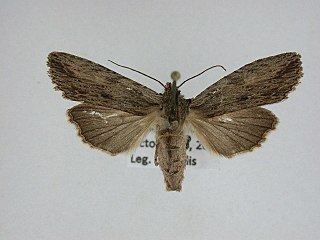
Lithophane signosa, the signate pinion or sycamore pinion moth, is a species of moth in the family Noctuidae. The species was described by Francis Walker in 1857. It is found in North America.
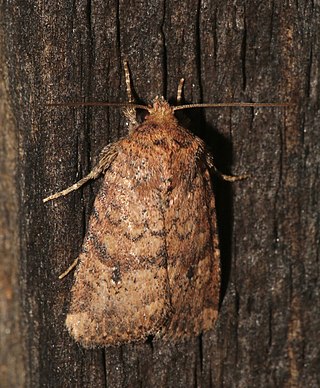
Homorthodes furfurata, the northern scurfy Quaker moth or scurfy Quaker moth, is a species of moth in the family Noctuidae . It was described by Augustus Radcliffe Grote in 1874 and is found in forest habitats in North America. Its range extends across the continent, to south-eastern Canada, Massachusetts, New York, and Mississippi. In the west it ranges south to California, Arizona, New Mexico and Texas.
Parabagrotis cupidissima is a species of moth in the family Noctuidae. It was described by Augustus Radcliffe Grote in 1875 and is found in North America, where it ranges from southern Vancouver Island, along the Pacific Coast states, to southern California. The habitat consists of grasslands and oak woodlands.
Pero radiosaria is a species of moth in the family Geometridae. It was described by George Duryea Hulst in 1886 and is found in North America, where it has been recorded from southern California to Texas.
Lacinipolia incurva is a species of moth in the family Noctuidae. It was described by John B. Smith in 1888 and is found in North America, where it has been recorded from California, Arizona, New Mexico, Texas, Utah and Colorado.
Parabagrotis insularis is a species of moth in the family Noctuidae. It is found in North America, where it has been recorded from southern Vancouver Island, along the Pacific Coast through California to near the border with Mexico. The species was described by Augustus Radcliffe Grote in 1876.
Xestia verniloides is a species of cutworm or dart moth in the family Noctuidae. It was described by J. Donald Lafontaine in 1998 and is found in North America.
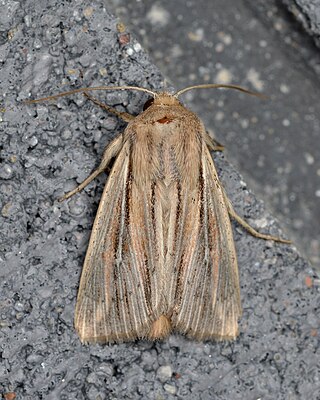
Leucania commoides, the comma wainscot or two-lined wainscot moth, is a species of cutworm or dart moth in the family Noctuidae. It was described by Achille Guenée in 1852 and is found in North America.

Meropleon ambifusca, or Newman's brocade, is a species of cutworm or dart moth in the family Noctuidae. It was described by Newman in 1948 and is found in North America.

Papaipema speciosissima, the osmunda borer or regal fern borer, is a species of cutworm or dart moth in the family Noctuidae. It was described by Augustus Radcliffe Grote and Coleman Townsend Robinson in 1868 and is found in North America.

Pero occidentalis, the western pero, is a species of geometrid moth in the family Geometridae. It was described by George Duryea Hulst in 1896 and is found in North America.
Euamiana endopolia is a moth in the family Noctuidae. It was described by Harrison Gray Dyar Jr. in 1912 and is found in North America.
Xestia laxa is a species of cutworm or dart moth in the family Noctuidae. It was described by J. Donald Lafontaine and Kauri Mikkola in 1998 and is found in North America.

Baileya levitans, the pale baileya, is a species of nolid moth in the family Nolidae. It was described by Smith in 1906 and is found in North America.
Perigonica pectinata is a species of cutworm or dart moth in the family Noctuidae. It was described by Smith in 1943 and is found in North America.
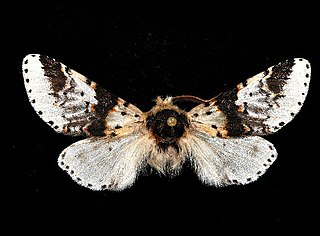
Furcula scolopendrina, the zigzag furcula moth or poplar kitten moth, is a species of prominent moth in the family Notodontidae. It was described by Jean Baptiste Boisduval in 1869 and is found in North America.

Tesagrotis corrodera is a species of cutworm or dart moth in the family Noctuidae. It was described by Smith in 1907 and is found in North America.
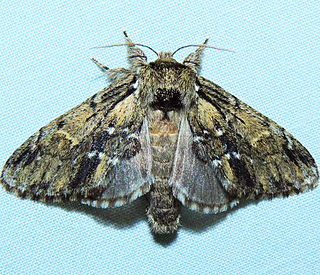
Hyperaeschra georgica, the Georgian prominent, is a species of moth in the family Notodontidae. It was first described by Gottlieb August Wilhelm Herrich-Schäffer in 1855 and it is found in North America and parts of Australia.










